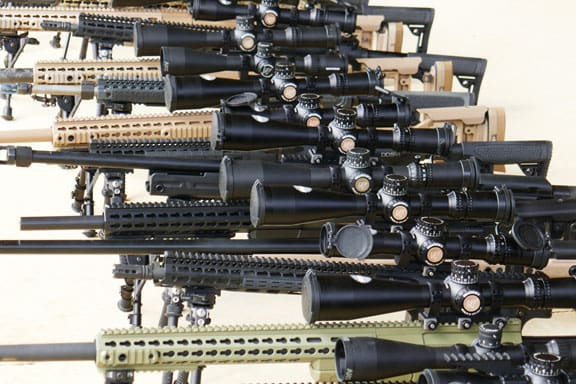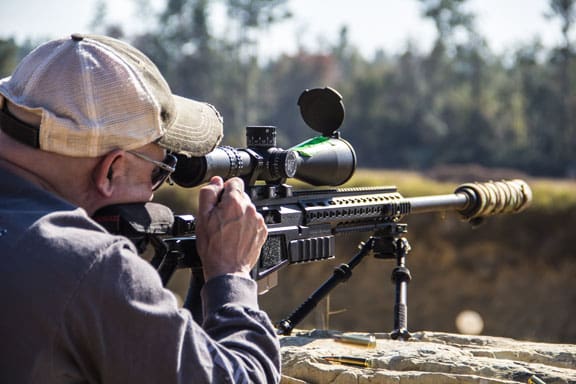
Since their introduction in 2013, Nightforce’s ATACR line of first focal plane scopes has been very well-received by the long range shooting community. These scopes provide the ruggedness of the NXS line while offering the advantages of a FFP reticle and a 34mm main tube. Even better, the price point is very reasonable compared to the competition. Now, long range shooters seeking more magnification than offered by the ATACR 4-16×42 or the 5-25×56 will undoubtedly welcome this new addition to the ATACR line.

This new model hits all of the notes that long range shooters want to hear:
34mm main tube for increased elevation adjustment and light transmission;
56mm objective;
ED Glass (same glass as featured on the Nightforce B.E.A.S.T.);
First Focal Plane (FFP) Reticle;
Side parallax adjustment (10 meters to infinity);
Zero Stop feature (i.e. return to zero elevation turret) ;
Illuminated reticle;
Tenebraex brand flip covers;
Power throw lever (removable if not desired); and
Three reticle options: MIL/R, MOA/R, Horus TMR 2

This scope has a length of 16 inches and a weight of 39.3 ounces, which is quite manageable considering its 5x power range and 35x maximum power setting. Given that many of these scope will reside on rifles chambered in magnum calibers such as .338 Lapua or even .50 BMG, the extra weight will not even be noticed.

As with all scopes in the ATACR line up, the turrets are a definite high point. In addition to the trademark Nightforce knurling, these turrets provide 100 MOA / 27 MIL of elevation adjustment and 60 MOA / 16 MILs of windage. This is sufficient elevation adjustment to get many rounds in target at a mile. Perhaps even more impressive is that each full rotation of the turret provides either 30 MOA or 12 MILs of adjustment. As a practical matter, this means that shooters will, in many cases, be able to reach out to 1000 yards without ever having to dial past the first revolution.
The engraving on the turrets is large and easy to read, even in low light conditions. Here is a photo of the MIL turret with 12 MIL of hashmarks per revolution, in 0.1 Mil increments:

And another of the MOA turret showing 30 MOA hashmarks per revolution, in ¼ MOA increments:

The windage turret is capped, as shown below, in order to prevent the dial from being accidentally moved off of zero. Since many long range shooters dial for elevation but hold for wind, this is an ideal set-up.

I neglected to take a photo of the windage turret with the cap off, but it is similar in appearance and ruggedness to the elevation turret. Unlike many capped turrets, the Nightforce ATACR windage turret is built to be exposed, so you could conceivably just leave the cap at home and not worry about damaging the scope.

I and other invitees had a chance to work with the ATACR 7-35×56 at the Nightforce Media Event held at CORE Shooting Solutions in Baker, Florida. In contemplating this ultra-high magnification scope with 7x range, I was particularly interested in three performance aspects:
How generous is the eye-box? Often scopes with high magnification range will have unforgiving eye boxes, particularly at the maximum power setting.
What is the light gathering ability at maximum magnification? In many cases, ultra-high magnification scopes get pretty dim and/or milky at their max power setting
How sharp is the resolution of the glass? Scopes with 7X or more power range can often get soft around the edges.
Based on my initial observations, the ATACR passes muster in all three areas. First, the eye-box is very forgiving, even at its maximum power setting. Second, while the scope is certainly not as bright at the 35X setting as it is at 20X, I was pleasantly surprised at just how bright it is. Both resolving power and brightness were still excellent at 35X. It certainly exceeded my expectations, given my experience with older generations of 35X and 42X benchrest scopes.

Finally, I was also pleased with the resolving power of the ED glass. I was not, however, able to arrive at any definitive opinions (for example, to conclude that the resolution is better or worse than competing brand X). Most of our shooting at CORE was done into the sun and occasionally with some mirage present, both of which make it hard to objectively evaluate resolution. The Florida humidity may have also played a role as well. Perhaps more importantly, I didn’t have any other scopes available as a reference point. Even so, it is safe to say that Nightforce’s ED glass consistently ranks high in this category and I have no reason to think that further testing on this scope would not confirm similar results.
Furthermore, I was certainly able to identify and hit targets which were often backlight or in the shade, out to 1050 yards, using both the ATACR 7-35 and 4-16 models. In one drill we ran, I could barely see a clay pigeon in the shade using the 4-16×42 at 740 yards. We were using the clay pigeon as a reference point to hit a full size IPSC target located just below line of sight. Other shooters seemed to have a somewhat easier time resolving the clay pigeon. Even so, I still got 5/5 hits on the steel target. Nonetheless, I went back later with the 7-35×56 and could see the same clay pigeon with much more clarity, even though it was later in the day and the sun was going down. If anything, my experience with these scopes makes me want to get one for my new AR-10 chambered in 6.5 Creedmoor.

The major components of this scope are manufactured in Japan. Final assembly and quality control are done in the Nightforce plant in Orofino, Idaho. MSRP is $3600 ($4000 for the optional Horus reticle). I think this scope will be an ideal fit for shooters who desire a rugged optic designed to reach out to 1000-1600 yards or beyond.





35/7=5
Derp. Thanks. Correction made!
“Here is a photo of the MIL turret with 12 MIL of hashmarks per revolution, in 0.1 MOA increments:”
I think you meant 0.1 Mils
Yes, Thanks. Correction made
I’m assuming that’s a typo on the first turret picture? It’s very odd to have 0.1 MOA adjustments on a MIL turret.
I would be interested in seeing how small the eye pocket is at full magnification. Probably not a lot of latitude there!
Nightforce scopes are really stunning and so are the prices. Worth it? I think so, if you have the need. If not, then not.
I like it!
Anyone want to buy a kidney? Do you know of a buyer who will give me a good price?
Me likey but will settle for the NXS 8-32×56 for a whole lot less money. My NXS 5.5-22×50 is the pride and joy of my weapons mounted optical collection. The fit, finish and function on these scopes is just incredible. They are a joy to use and you could probably quick detach, beat a bad guy to death with it, reattach and not lose zero.
Comments are closed.